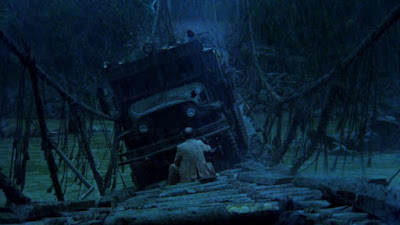Sorcerer (1977): William Friedkin's Gritty Masterpiece of Suspense and Desperation
In 1977, acclaimed director William Friedkin embarked on a cinematic journey that would push the boundaries of suspense and deliver a gritty masterpiece – Sorcerer. A remake of Henri-Georges Clouzot's 1953 film The Wages of Fear, Friedkin's version took the essence of the original and transformed it into a visceral and intense experience that has left an indelible mark on cinema history.
Sorcerer is not a typical Hollywood blockbuster. It's a slow-burning tale of desperation, survival, and the human condition. Set in the South American jungle, the film follows four men from different walks of life who find themselves in a small, poverty-stricken village. Roy Scheider leads the cast as Jackie Scanlon, a New Jersey mobster on the run. Alongside him are a French investment banker played by Bruno Cremer, a Mexican hitman portrayed by Francisco Rabal, and a Palestinian terrorist played by Amidou. Each of them is seeking refuge from their past, but circumstances force them into a dangerous mission – transporting unstable nitroglycerin through treacherous terrain to extinguish an oil well fire.
One of the film's notable achievements is its remarkable cinematography by John M. Stephens. The lush, oppressive jungle becomes a character of its own, contributing to the tension and despair that permeate the narrative. Friedkin's decision to shoot on location in the Dominican Republic added authenticity to the film, immersing the audience in the harsh reality faced by the characters.
The film's title, Sorcerer, is both metaphorical and literal. It refers to the highly volatile nitroglycerin the men transport, aptly nicknamed "sorcerer" due to its unpredictability. However, the term also encapsulates the mystical and almost supernatural forces that seem to govern the characters' fate. As the men navigate the perilous journey, the jungle becomes a malevolent force, testing their physical and mental limits.
Friedkin's direction is meticulous, building suspense with a deliberate pace that intensifies as the journey progresses. The director skillfully explores the psychological toll of fear, distrust, and isolation on the characters, offering a deep insight into the human condition under extreme duress. The film's sound design, crafted by Jack Murphy and Robert Knudson, enhances the immersive experience, with every creaking truck and thunderous explosion contributing to the palpable tension.
Despite its critical acclaim and the pedigree of its director, Sorcerer faced a challenging reception upon its release. Sandwiched between the success of The Exorcist and the burgeoning popularity of Star Wars, the film struggled at the box office. Audiences and critics alike were perhaps unprepared for Friedkin's departure from the supernatural horror genre. However, over the years, Sorcerer has gained a cult following, with cinephiles appreciating its unique blend of suspense, character development, and visual storytelling.
The legacy of Sorcerer endures as a testament to William Friedkin's commitment to pushing cinematic boundaries. Its influence can be seen in subsequent films that delve into the psychological depths of characters facing insurmountable odds. In hindsight, Sorcerer stands as a timeless work that transcends its initial reception, leaving an indelible mark on the landscape of suspenseful cinema. As audiences continue to rediscover this hidden gem, it remains a testament to the power of storytelling that defies convention and captures the raw essence of human struggle against an unforgiving world.
Trailer:

Comments
Post a Comment